Mi SciELO
Servicios Personalizados
Revista
Articulo
Indicadores
-
 Citado por SciELO
Citado por SciELO -
 Accesos
Accesos
Links relacionados
-
 Citado por Google
Citado por Google -
 Similares en
SciELO
Similares en
SciELO -
 Similares en Google
Similares en Google
Compartir
Medicina y Seguridad del Trabajo
versión On-line ISSN 1989-7790versión impresa ISSN 0465-546X
Med. segur. trab. vol.59 no.230 Madrid ene./mar. 2013
https://dx.doi.org/10.4321/S0465-546X2013000100003
Design of a questionnaire on the quality of occupational health nursing at the safety management services
Diseño y validación de un cuestionario de calidad de los cuidados de Enfermería del Trabajo en los Servicios de Prevención
Esperanza Alonso Jiménez1, Pedro Cabeza Díaz2, Gemma Gutiérrez Fernández2, Ana Rosa Pérez Manjón2, Pablo Tomé Bravo2
1. Spanish Federation of Occupational Health Nursing (FEDEET).
2. Cantabrian Association of Occupational Health Nursing (ACET).
ABSTRACT
Introduction and Aim: The main aim of this study is to draw up a "Questionnaire on Satisfaction with Occupational Health Nursing" (Cuestionario de satisfacción con los cuidados de la enfermería del trabajo - CUSACET), which will enable us to gauge users' perceptions with regard to the occupational health nursing work carried out by the various safety management services.
Materials and Method: The questionnaire is designed to encompass three dimensions:
a. Sociodemographic: consisting of four items.
b. Opinion of the safety management services: consisting of fifteen items.
c. Opinion of care received from the nursing staff at the safety management service, measured by twenty-three items.
We opted to do the validation according to the basic criteria of Moriyama and by applying Cronbach's Alpha index. To this end, 55 control questionnaires were given out at various safety management services in Cantabria. The questionnaires were collected and the data recorded onto the statistical analysis program SPSS v.15.
Results: The criterion established for validity was exceeded, with results above 80% in assessment by experts in accordance with Moriyama's basic criteria.
We encountered good internal consistency, as evidenced by a Cronbach Alpha coefficient of 0.837 in each section.
Conclusions: This paper presents a new instrument, specifically designed to measure the quality of occupational health nursing care through the perceptions of the users who receive it which is reliable and easy to use.
Key words: Quality of Health Care, Questionnaire, Personal Satisfaction, Quality Improvement, Occupational Health Nursing, Safety Management.
RESUMEN
Origen y objetivos: El objetivo principal de este trabajo será elaborar un cuestionario que nos permita conocer la percepción de los trabajadores sobre las actividades que realiza la enfermería del trabajo en los diferentes Servicios de Prevención.
Método: El cuestionario se divide en tres partes: 1) Variables sociodemográficas, formadas por 4 items; 2) Opinión sobre el servicio de prevención, formado por 15 items; 3) Opinión de los trabajadores sobre la atención de enfermería, formado por 23 items. Se analizó el comportamiento métrico del cuestionario respecto a la validez de constructo, de criterio y la consistencia interna, para lo cual, se opta por hacerlo según los criterios básicos de Moriyama y el cálculo de índice ∂ de Conbrach. Para ello se repartieron 55 cuestionarios de control en los diferentes servicios de prevención de la Comunidad de Cantabria y se trataron los datos con el programa SPSS v.15 de análisis estadístico.
Resultados: Se superó el criterio de validación establecido, con resultados superiores al 80% en la valoración de los expertos. Encontramos una buena consistencia interna, evidenciada por un Alfa de Cronbach de 0.837 en cada sección.
Conclusión: El cuestionario reúne suficientes propiedades psicométricas para ser considerado una herramienta útil y fiable capaz de medir con objetividad la satisfacción de los trabajadores con los cuidados de la enfermería del trabajo.
Palabras clave: Calidad del Cuidado, Cuestionario, Satisfacción Profesional, Mejora calidad, Enfermería del trabajo, Servicios de Prevención.
Introduction and aim
Quality is an inherent facet and property which allows things to be compared with others of their same kind1. One might argue that it is a subjective appreciation; what the users of any service want and trust - especially when the service in question is related to health - is that all of their needs and requirements will be satisfied, and for this reason quality depends upon how these are addressed2. When the perception is one of satisfaction, a relationship of quality can be said to have been established, giving added value to the work carried out.
Occupational health nursing has a broad field of application, with users being exposed to multiple risk factors and harmful agents. These in turn cause a multitude of pathologies and illnesses which, unless they are watched for and detected in time, develop into occupational diseases or disabilities which are negative for all concerned3.
As specialists in this area, we therefore have a high degree of responsibility in our daily work; in those duties and functions which, as professionals, we must fulfil at all times with the diligence and competence expected of us.
In carrying out our work, we must consequently pay close attention not only to technical, scientific and managerial quality, but also to those other aspects which are important to the users of our services. Day-to-day assessment by our users helps us to improve these aspects, which we ourselves are not always aware of, but which are key in terms of raising our standards of service and of professional quality.
Occupational health nursing staff participate actively in the compulsory audits of the safety management services where they work, covering the work carried out, management and compliance with current occupational health legislation. As a result, they must become involved in studying the quality of the care they provide by gauging users' perceptions. This will enable them to adapt and shape this care to satisfy users' perceived needs. With this in mind, we have designed this questionnaire, which will be of use when submitting ourselves to audit by the final users of our care.
Our review of the bibliography on instruments to measure the quality of nursing care revealed the main reference work to be a study by L.H.Thomas, in which he produces and validates a nursing quality assessment instrument known as the "Newcastle Satisfaction Nursing Scales (NSNS)" 4,5.
The translation into Spanish, cultural adaptation and subsequent validation were carried out by R. Alonso, giving rise to the "Nursing Quality Questionnaire" (Cuestionario de medición de calidad del cuidado de enfermería - CUCACE 6.
Our interest in drafting our own questionnaire stems from the fact that there is currently no other in the field of occupational health nursing. Those which do exist are designed for clinical nursing and cannot be applied to the specificities of our field.
The main aim of this study is to draw up a "Questionnaire on Satisfaction with Occupational Health Nursing" (Cuestionario de satisfacción con los cuidados de la enfermería del trabajo - CUSACET), which will enable us to gauge users' perceptions with regard to the occupational health nursing work carried out by the various safety management services.
Our secondary aim is for the questionnaire to identify aspects of our care which can be improved.
Materials and methods
In order to assess users' perceptions, we opted to produce and validate a questionnaire, understood as a tool to collect information. The questionnaire is designed to quantify and generalise this information, in addition to standardising the procedure, with the aim of comparing and contrasting information1.
The questionnaire (CUSACET), is designed to encompass three dimensions7:
d) Sociodemographic: consisting of four items, which will help us to classify users according to age, sex, education and employment sector.
e) Opinion of the safety management services: consisting of fifteen items, which will give us the users' appraisal of various aspects of the safety management service to which they belong: general impression, customer service, medical tests, accident and emergency services and facilities.
f) Opinion of care received from the nursing staff at the safety management service, measured by twenty-three items.
In order to obtain these opinions, we have opted to use Likert's scale to quantify each item, with participants being asked to rate the extent to which they agree or disagree. A scale of 1 to 5 is used, where 1 represents the lowest degree of satisfaction and 5 the highest.
Having designed the three dimensions of the questionnaire and all of the items, we turned our attention to the matter of validation. We opted to do this according to the basic criteria of Moriyama and by applying Cronbach's Alpha index8.
We targeted a minimum expert rating of 80%.
Internal reliability: Cronbach's Alpha index
For this calculation, we considered a significant correlation to be one whose coefficient was 0.65 or above. The closer the Cronbach Alphacoefficient is to 1, the more consistent is the test.
Basic criteria of Moriyama
In order to validate the questionnaire (Annex III), it was sent to five experts in occupational health nursing, together with eight questions (Table I) on the suitability of the items, ease of completion and understanding, and whether the questionnaire is likely to be a helpful instrument for occupational health nursing staff in their day-to-day work. The experts, answering by e-mail, had to rate each question from 1 (totally disagree) to 5 (totally agree). Each question thus had a maximum of 25 points, which would signify the experts' complete agreement with the questionnaire's designers.
Table I. CUSACET Questionnaire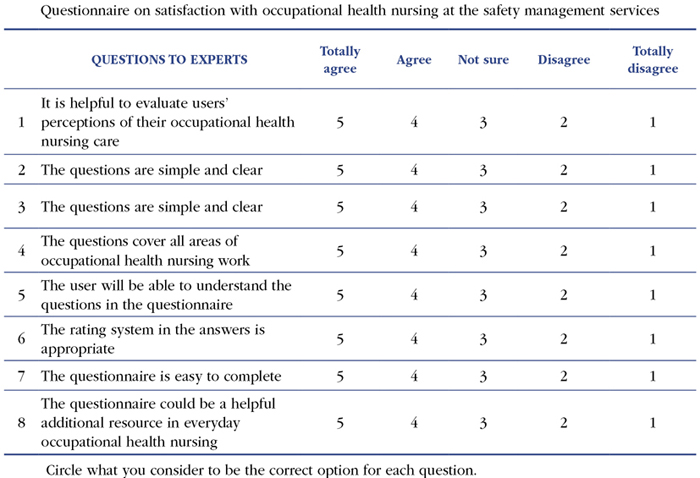
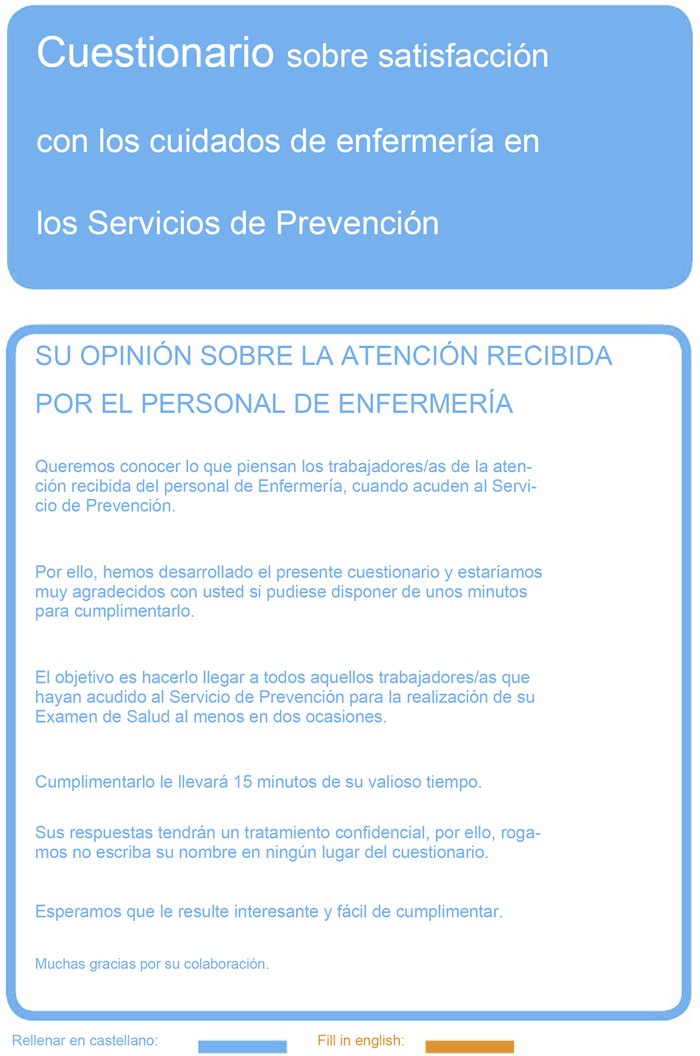
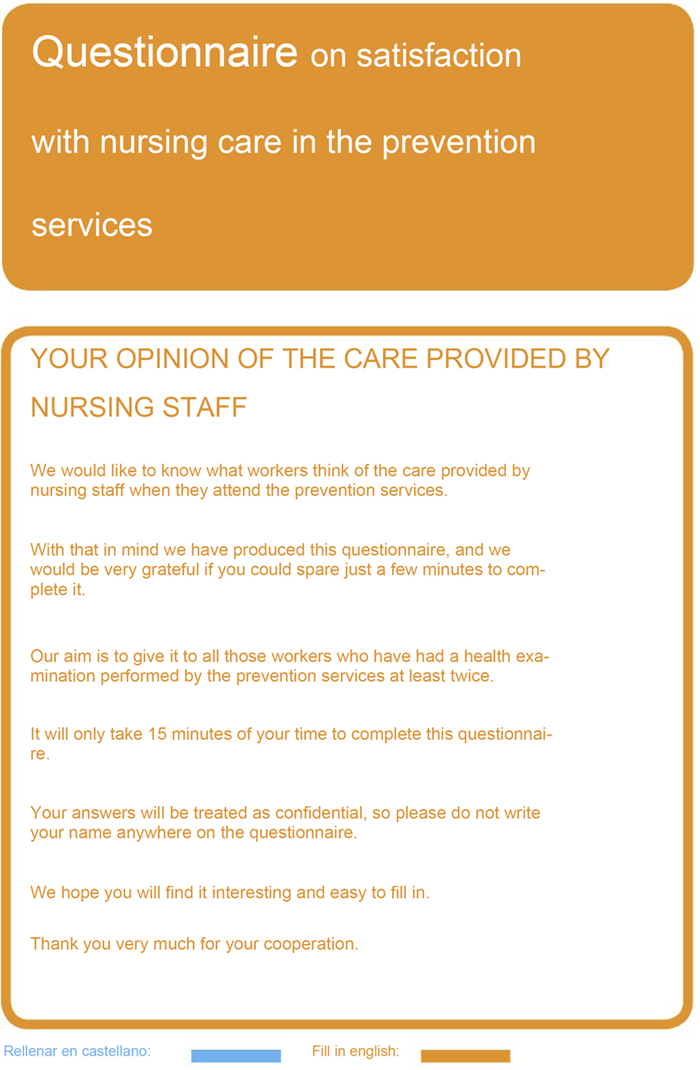
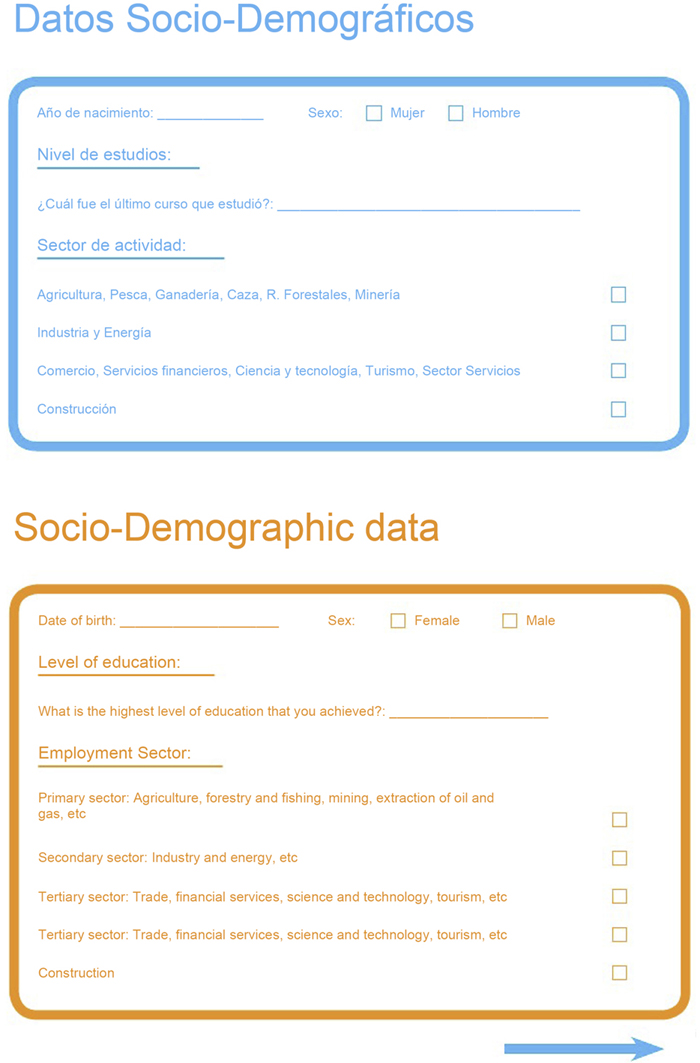
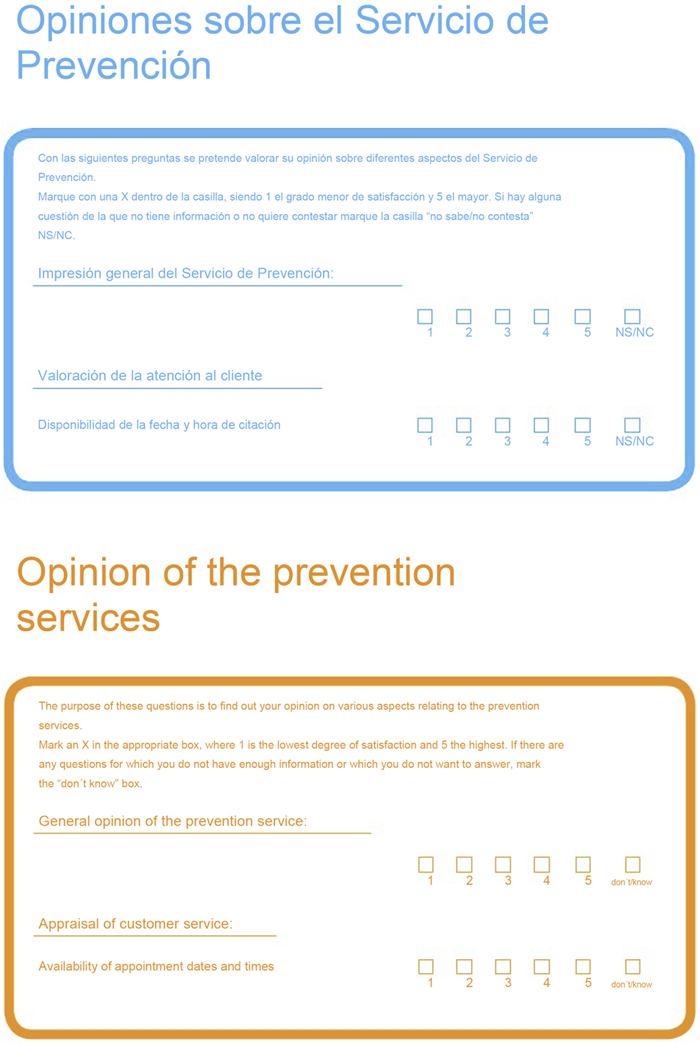
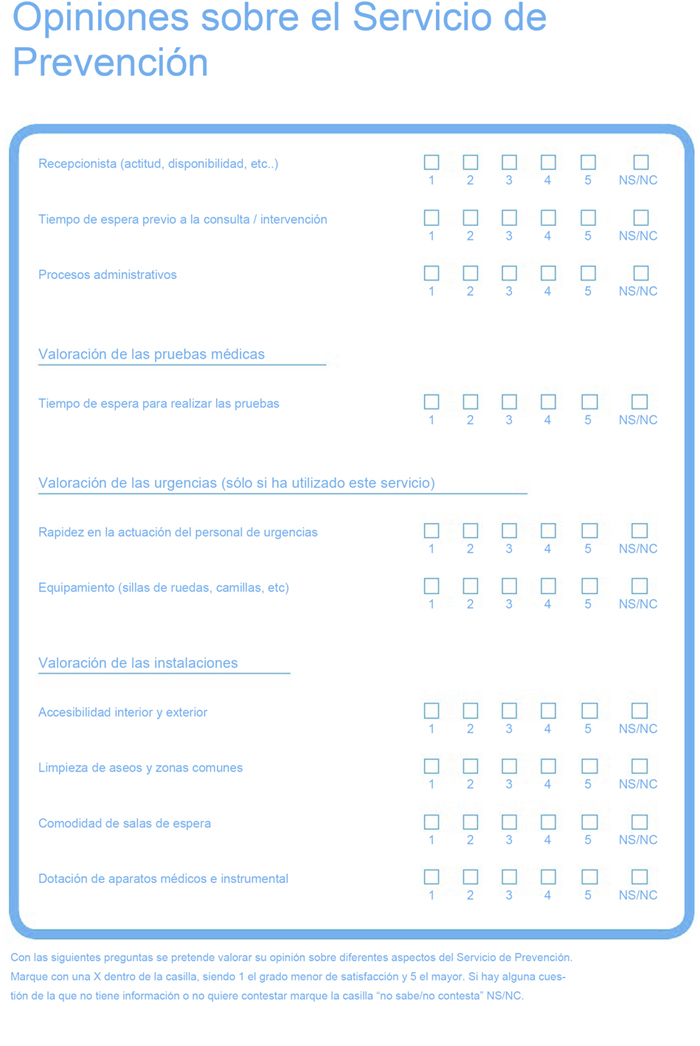
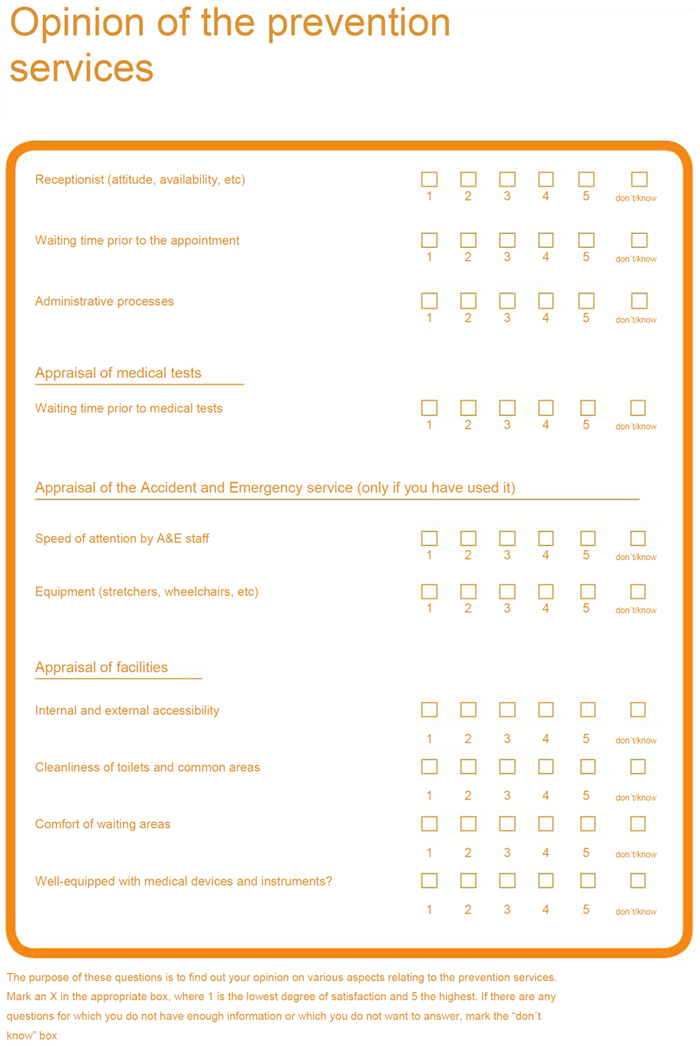
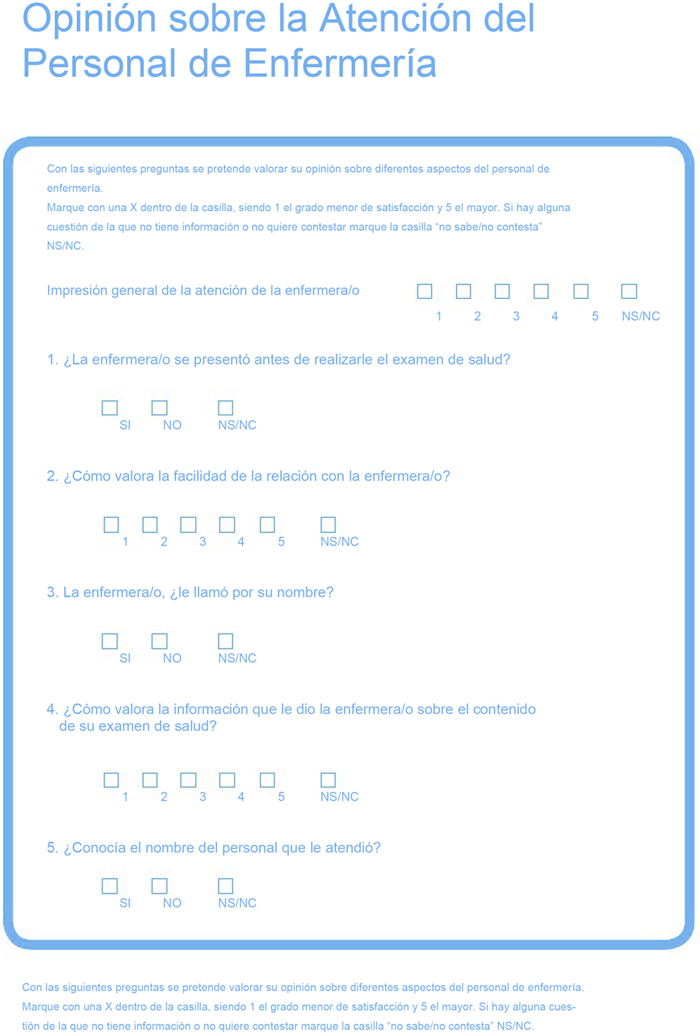
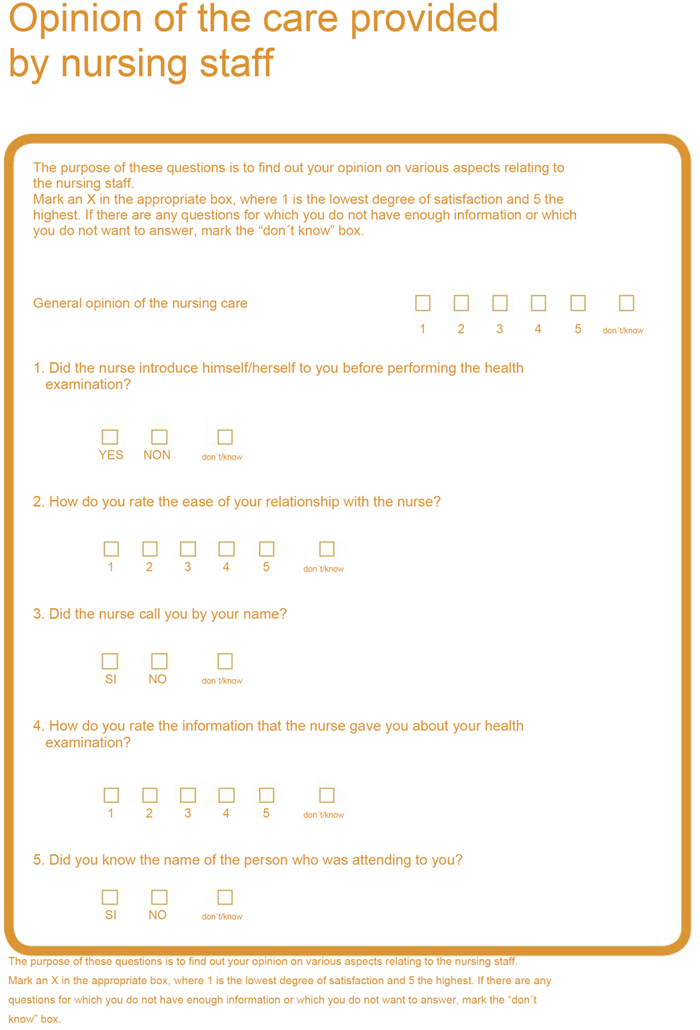
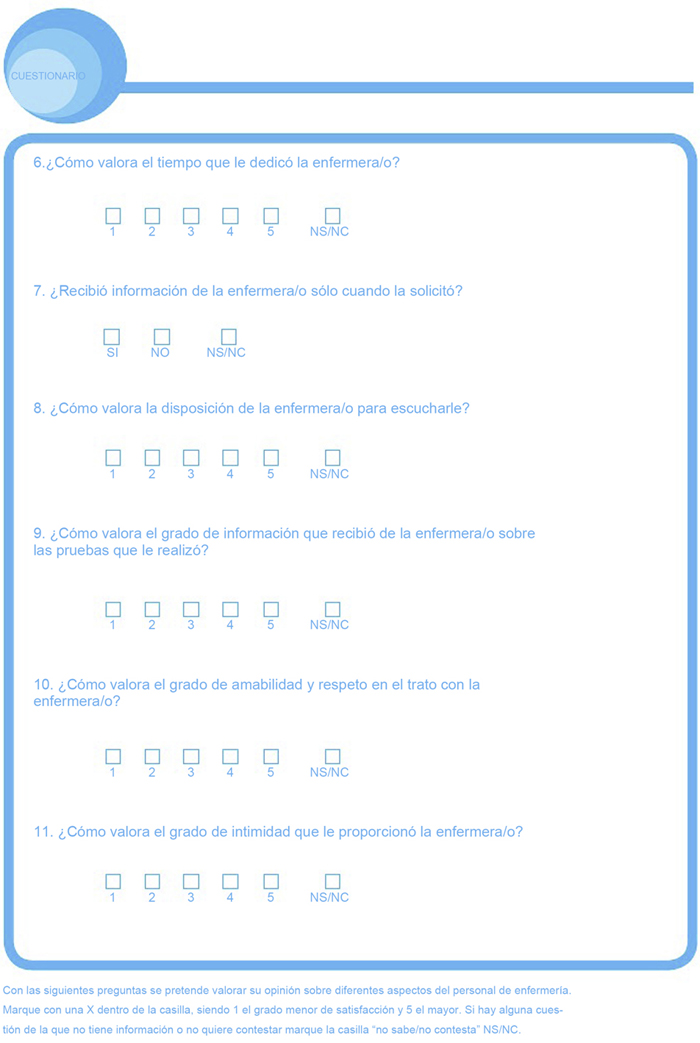
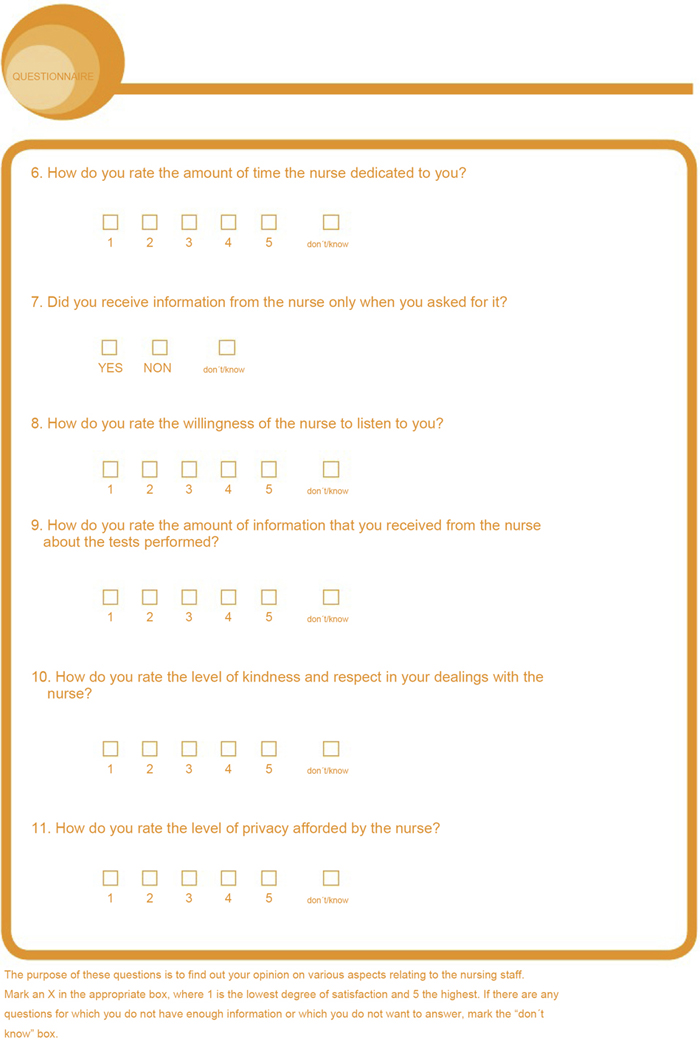
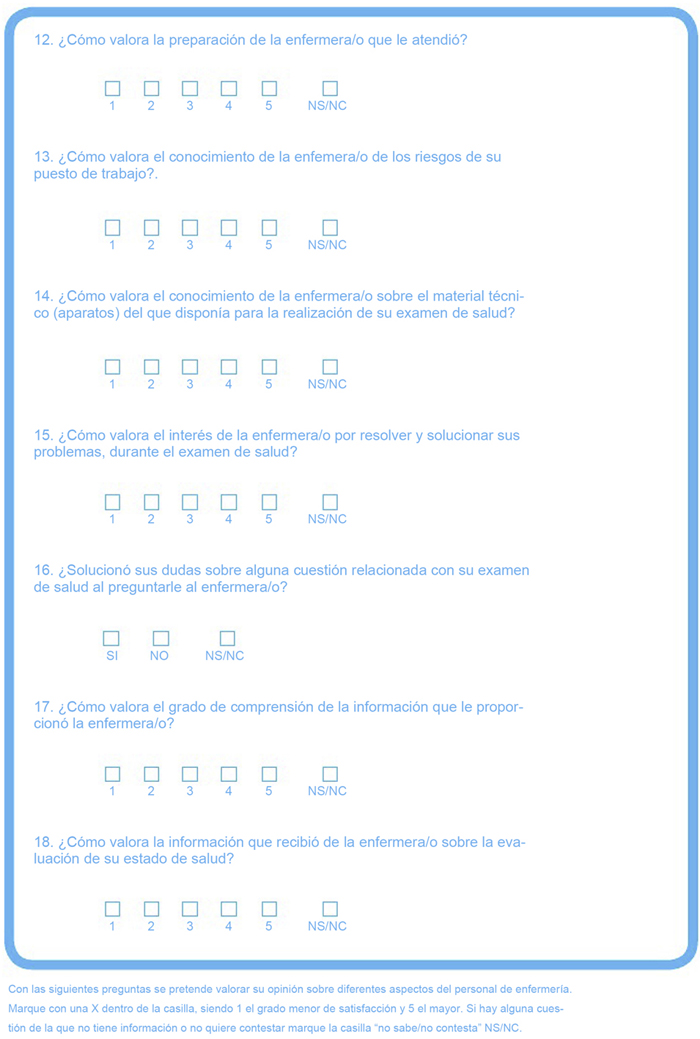
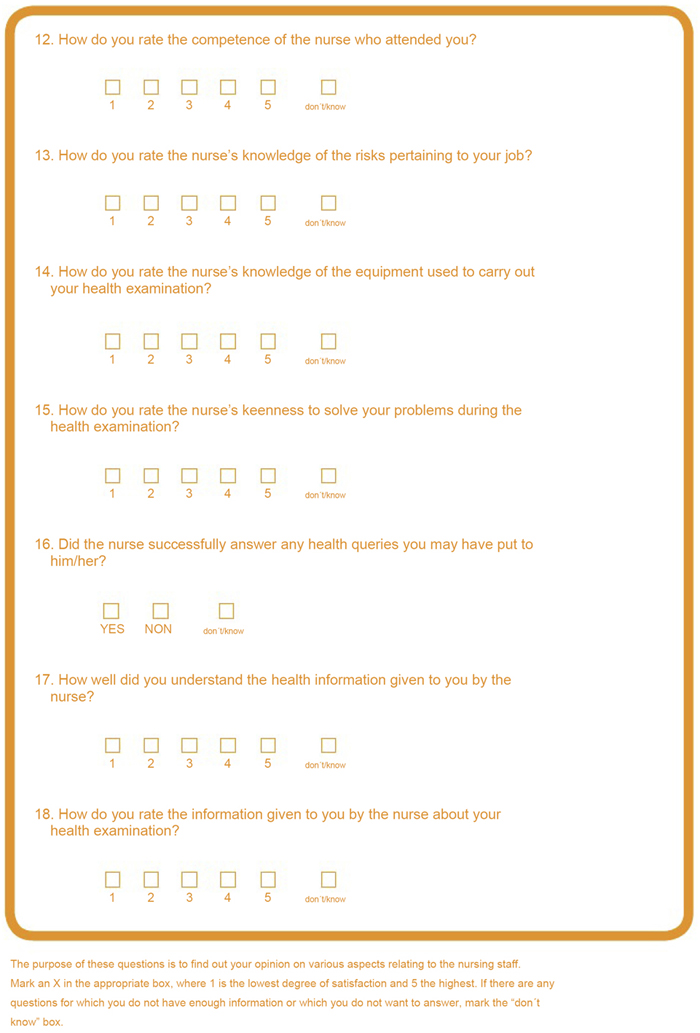
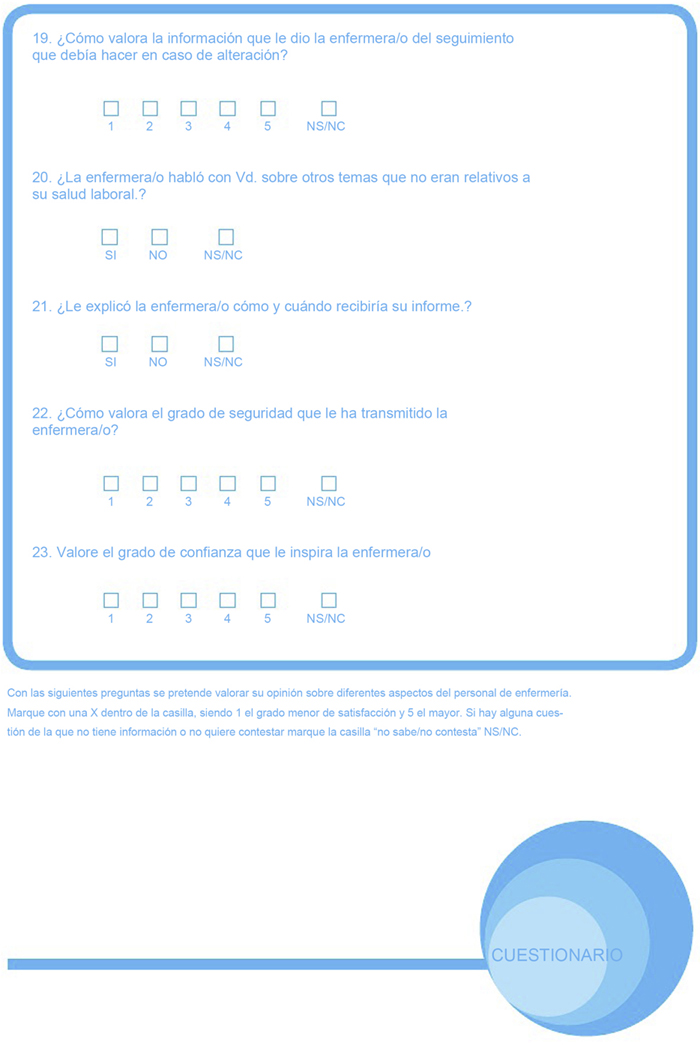
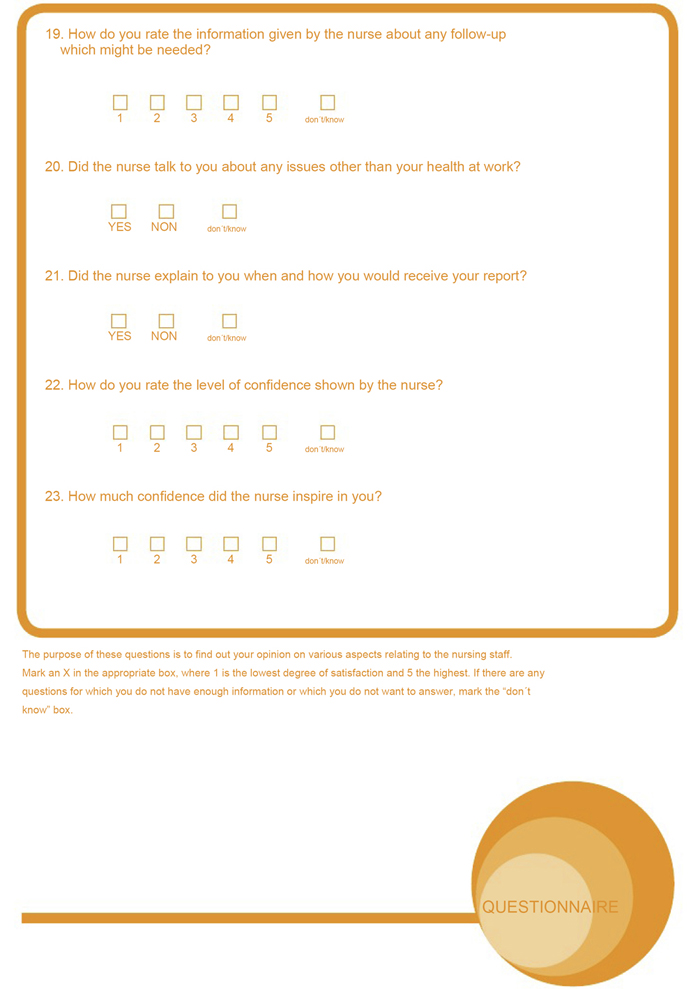
Cronbach's Alpha index
This coefficient was calculated in order to validate the internal consistency of the questionnaire10; to this end, 55 control questionnaires were given out at various safety management services in Cantabria during the month of December. The users chosen consisted of 9 who were undergoing a health examination at their employer's safety management service and 46 at an external service. The questionnaires were collected and the data recorded onto the statistical analysis program SPSS v.15.
Results
In order to validate the questionnaire under Moriyama's methodology, we e-mailed the questionnaire and the questions regarding suitability to five specialist occupational health nurses. On receipt of their answers, their expert opinions to the eight questions were analysed.
We will now proceed to analyse their responses question by question.
Analysis of questions to experts
1. It is helpful to evaluate users' perceptions of their occupational health nursing care: this question received a total of 24 points (96%), which indicates that the experts consider the questionnaire to be appropriate and helpful for occupational health nursing.
2. The questions are simple and clear: the responses give a rating of 22 points (88%), meaning that, in the experts' opinion, the questions are suitable.
3. The data is well ordered and structured: this question received a total of 21 points (84%), indicating that the questionnaire is well-structured, though improvable.
4. The questions cover all areas of occupational health nursing work: this item also received 21 points (84%), from which we deduce that it covers most aspects of our work.
5. The user will be able to understand the questions in the questionnaire: the experts gave this question 23 points (93%), therefore they consider that any person would be able to complete the questionnaire.
6. The rating system in the answers is appropriate: this question also received 23 points (93%), meaning that the experts agree with the rating system used to give numerical values to the responses.
7. The questionnaire is easy to complete: again, 23 points (93%), meaning that nobody will have difficulties in filling it out.
8. The questionnaire could be a helpful additional resource in everyday occupational health nursing: the experts' score of 22 points (88%), shows that they believe the questionnaire to be useful to occupational health nurses in their day-to-day work.
In Table II we can see the breakdown of the experts' scores according to Moriyama's basic criteria.
Table II. Expert opinion results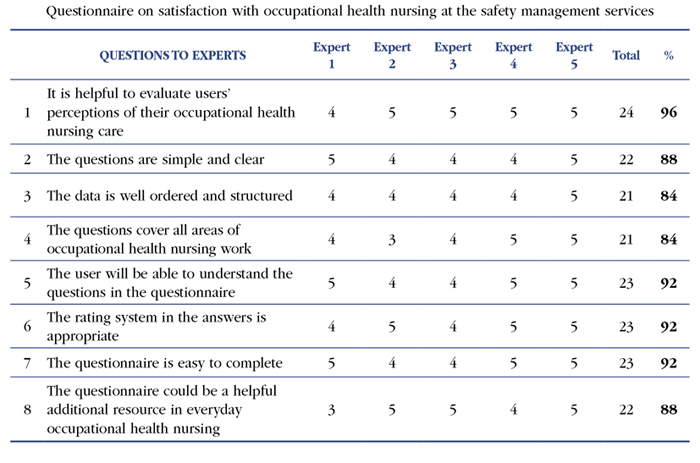
Taking into account the scores for each of Moriyama's principles, all of which exceed the previously established validity criterion of 80% expert support, we consider the proposed items to be valid. Thus, the questionnaire stays at 43 items, as reflected in the methodology.
A calculation was carried out for each section of the questionnaire, with the following results:
The section "Opinion of the Safety management Service" obtains a Cronbach Alphacoefficient of 0.837. (Table III)
Table III. Reliability statistics
The section "Opinion of the care provided by nursing staff" obtains a Cronbach Alpha coefficient of 0.837 (table IV).
Table IV. Reliability statistics
Table V (Annex I) shows the breakdown of valid responses for each item
Tabla 5. Breakdown (%) of valid responses per item
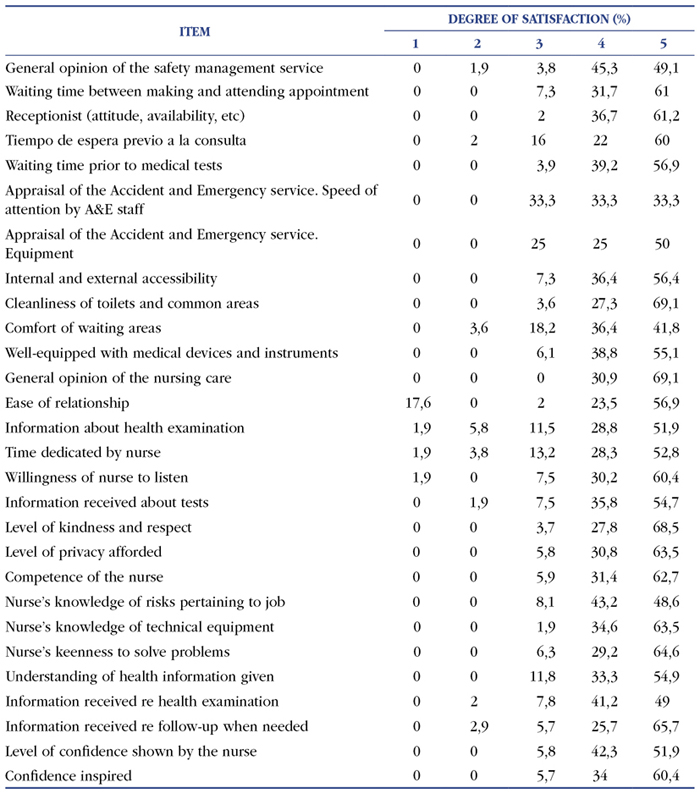
Table VI (Annex II) gives a breakdown of valid and non-valid valid responses for each item.
Table 6. Data re. valid and non-valid responses
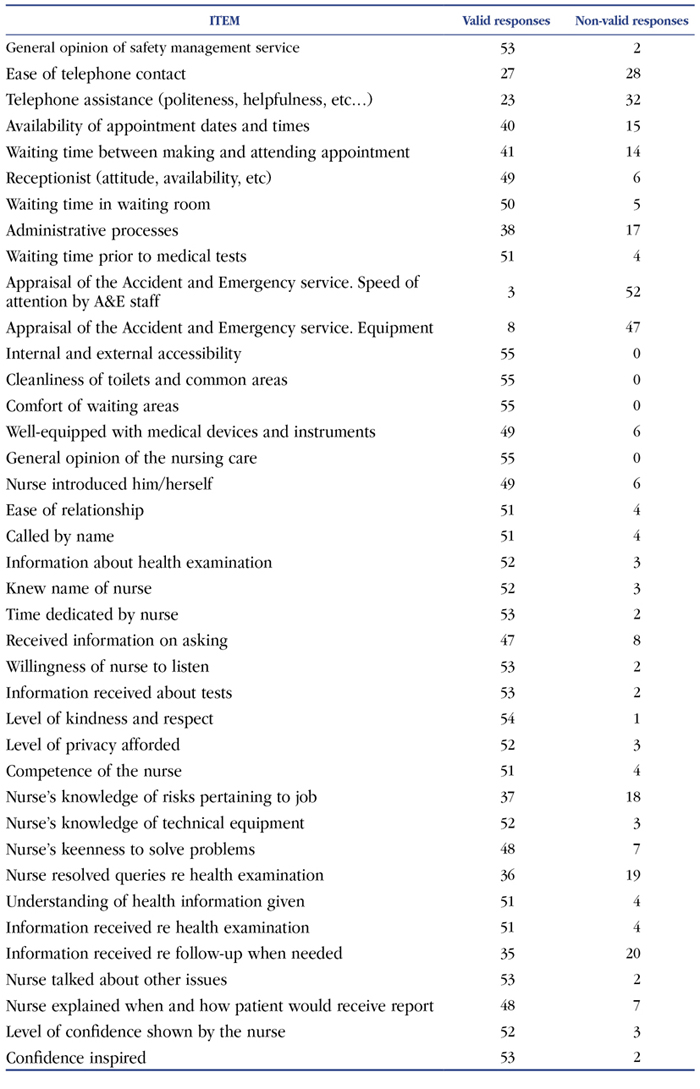
Discussion, conclusions
This paper presents a new instrument, specifically designed to measure the quality of occupational health nursing care through the perceptions of the users who receive it.
The criterion established for validity was exceeded, with results above 80% in assessment by experts in accordance with Moriyama's basic criteria.
We encountered good internal consistency, as evidenced by a Cronbach Alpha coefficient of 0.837 in each section - very similar to that encountered by L.H. Thomas (4), who obtained an internal consistency of 0.96, and by R. Alonso(6), with 0.85 - making for an instrument which is reliable and easy to use.
It is worth pointing out that, for the question on general impression of nursing care received, which used a Likert scale of 1-5, not a single user gave a negative rating. This result is similar to that of R. Alonso, whose study produced 97% positive ratings.
On analysing the data referring to valid responses, we found that two questions - on "ease of contact by telephone" and "telephone assistance" - produced a large number of non-valid responses. This is because, when health examinations are scheduled, most users deal directly with the company employee responsible for organising them. Thus, the user has insufficient information to answer these questions on the questionnaire. For this reason, we decided to correct the questionnaire, and the proposed improvement can be seen in the new design.
In addition, the data referring to "appraisal of the accident and emergency service" need to be analysed separately, as only users whose company has an accident and emergency service can give a meaningful response.
These questions cannot be eliminated from the questionnaire, since they provide information on the quality of service in these cases.
![]() Correspondence:
Correspondence:
Pablo Tomé Bravo
S.P.Ibermutuamur.
P.I. Guarnizo, Centro de empresas, local 10 A
39611- Guarnizo (Cantabria). España
Phone: 942 56 50 57
pablotome@hotmail.com
Recibido: 14-11-12
Aceptado: 06-02-13
Bibliography
1. Martínez-Rodríguez R., Urdaneta Pignalosa G., Rosales Bordes A., Villavicencio Mavrich H. Cuestionario de evaluación de la calidad asistencial en un servicio de urgencias urológicas. Actas Urol Esp 2008 Ago (citado 2012 Feb 03);32(7):717-721. [ Links ]
2. Mira JJ, Lorenzo S, Rodríguez-Marín J, Buil JA. Concepto y modelos de calidad. Hacia una definición de calidad asistencial. Papeles del psicólogo 1999 Noviembre;74. [ Links ]
3. BO del Estado. Ley 31/1995, de 8 de noviembre, de Prevención de Riesgos Laborales. Boletín Oficial del Estado 1995;10. [ Links ]
4. Thomas L, McColl E, Priest J, Bond S, Boys R. Newcastle satisfaction with nursing scales: an instrument for quality assessments of nursing care. Quality in Health Care 1996;5(2):67-72. [ Links ]
5. Torres Contreras CC. Percepción de la calidad del cuidado de enfermería en pacientes hospitalizados. Avances en Enfermería 2010 jul-dic;28(2). [ Links ]
6. Alonso R, Blanco-Ramos M, Ganoso P. Validación de un cuestionario de calidad de cuidados de enfermería. Rev Calid Asist 2005;20(5):246-250. [ Links ]
7. Martín Arribas MC. Diseño y validación de cuestionarios. Matronas Profesión 2004;5(17):23-29. [ Links ]
8. Gonzalez Baltazar R, Hidalgo Santacruz G, Salazar JG, Preciado Serrano ML. Elaboración y validez del instrumento para medir calidad de vida en el trabajo "CVT-GOHISALO". Ciencia & Trabajo 2010;12.36:332-340. [ Links ]
9. Martínez Canalejo H. Manual de procedimientos bioestadísticos. Ciencias Médicas 1986:92. [ Links ]
10. Neugarten BL, Havinghurst RJ. The Life Satisfaction. In: Mc Dowell I, Newll C, editors. Measuring Health. A Guide to Rating Scales and Questionaries. 3rd ed.: Oxford: University Press; 1987. p. 326-28-331-32;334-37. [ Links ]











 texto en
texto en 


